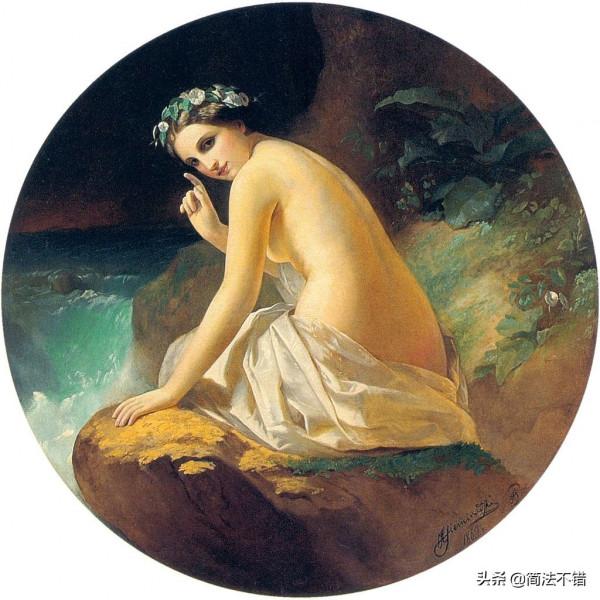亨利克·西米拉茲基 (Henryk Siemiradzki) 的超大幅油畫(11.9m x 9.6m)《克拉科夫大劇院的幕布》Curtain for the Juliusz Słowacki Theatre in Kraków賞析
關於作品

Curtain for the Juliusz Słowacki Theatre in Kraków
1894年,在克拉科夫市大劇院(今天的斯洛瓦茨基劇院),宣佈了一項為新建築繪製裝飾幕布的競賽。這座劇院至今仍被認為是歐洲最珍貴的戲劇建築之一。這幅幕布是由當時享譽歐洲的畫家亨利克·西米拉茲基 (Henryk Siemiradzki) 製作的,他同意無償繪製這幅作品,僅需要採購材料的費用, 創作過程中Siemiradzki保證了極高的藝術水平。
During the construction of the Municipal Theatre in Krakow (today's Słowacki Theatre in Krakow), a competition was announced for painting a decorative curtain for the new building. The building is still considered to be one of the most precious monuments of theatrical architecture in Europe. The curtain was commissioned from Henryk Siemiradzki, a painter famous throughout Europe at that time, who agreed to produce the work at the cost of the applied materials. Siemiradzki guaranteed not only a high artistic level, but also prestige.
1894 年 4 月 18 日,觀眾看到這副成品幕布。這幅畫的左側描述的是悲劇,婦女身著深色長袍,哀嘆她死去兒子的骨灰。而同時,一個笑著的喜劇演員坐在畫的底部,旁邊有小丑的陪伴。右側構成動態構圖,描繪了普賽克試圖擺脫性感的懷抱,翱翔於天空。 Siemiradzki 將作品的黑暗、悲慘的左側與明亮而樂觀的右側形成對撞。整個構圖類似於完美與和諧的同義詞——太極。
On 18 April 1894, The audience saw an oil painting on linen canvas, stretched on a wooden frame (11.9m x 9.6m ), depicting an allegory of theater.The left side of the painting features Tragedy, dressed in a dark robe, lamenting over the ashes of her Dying Son. A laughing Comedy is sitting at the bottom of the painting in the company of a Jester. The right side constitutes a dynamic composition depicting Psyche trying to break away from the embrace of Sensuality and soar into the sky. Siemiradzki contrasts the dark, tragic, left side of the image with its remaining part—bright and optimistic. The whole composition resembles a synonym of perfection and harmony—the shape of a circle.
關於作者

亨利克·西米拉茲基 (Henryk Siemiradzki) 1843年10月24日—1902年8月23日去世
Henryk Hektor Siemiradzki 是一位居住在羅馬的波蘭畫家,以其不朽的學術藝術而廣為人知。他以描繪古希臘羅馬世界和新約的場景而聞名,大部分作品歸波蘭、烏克蘭和俄羅斯的國家畫廊所有。
Henryk Hektor Siemiradzki was a Rome-based Polish painter, best remembered for his monumental Academic art. He was particularly known for his depictions of scenes from the ancient Graeco-Roman world and the New Testament, owned by national galleries of Poland, Ukraine and Russia.

Christ with Martha and Maria, 1886
他的許多畫作描繪了古代的場景,通常是陽光普照的田園風光或呈現早期基督徒生活的作品。他還畫了聖經和歷史場景、風景畫和肖像畫。他最著名的作品包括利沃夫歌劇院和克拉科夫的 Juliusz Słowacki 劇院設計的巨大幕布。
Many of his paintings depict scenes from antiquity, often the sunlit pastoral scenes or compositions presenting the lives of early Christians. He also painted biblical and historical scenes, landscapes, and portraits. His best-known works include monumental curtains for the Lviv Theatre of Opera and for the Juliusz Słowacki Theatre in Cracow.
1873年,Siemiradzki 因根據托爾斯泰的詩句創作的畫作《基督與罪人》獲得了帝國藝術學院院士的稱號。 1878年,作品《花瓶》獲得法國國家榮譽軍團勳章和巴黎世界博覽會金獎。在 1876 年至 1879 年間,Siemiradzki 在他的其他大型專案中為基督救世主大教堂(莫斯科)創作了壁畫。
In 1873 , Siemiradzki received the title of Academician of the Imperial Academy of Arts for his painting "Christ and a Sinner", based on a verse from Tolstoy. In 1878 he received the French National Order of the Legion of Honour and a Gold Medal of the Paris World's fair for the painting Flower vase. In 1876–1879 Siemiradzki worked on frescoes for the Cathedral of Christ the Saviour (Moscow) among his other large-scale projects.
1879 年,他向新成立的波蘭國家博物館提供了他最著名的作品之一,即 1876 年左右繪製的巨大的“Pochodnie Nerona”(尼祿的火炬)。1893年,Siemiradzki 為國家歷史博物館(莫斯科)創作了兩幅大型畫作,並於 1894 年為克拉科夫的 Juliusz Słowacki 劇院製作了巨大的幕布。
In 1879 he offered one of his best-known works, the enormous "Pochodnie Nerona" (Nero's torches), painted around 1876, to the newly formed Polish National Museum. Around 1893 Siemiradzki worked on two large paintings for the State Historical Museum (Moscow) and in 1894 produced his monumental curtain for the Juliusz Słowacki Theatre in Kraków.



















